A question I get on almost every cake video I share is “how do you get your frosting so smooth??” It’s almost like people think smooth buttercream is some kind of secret.
A lot of people think I’m using some special or obscure type of frosting, or that there’s a secret ingredient I include to create that silky smooth texture.
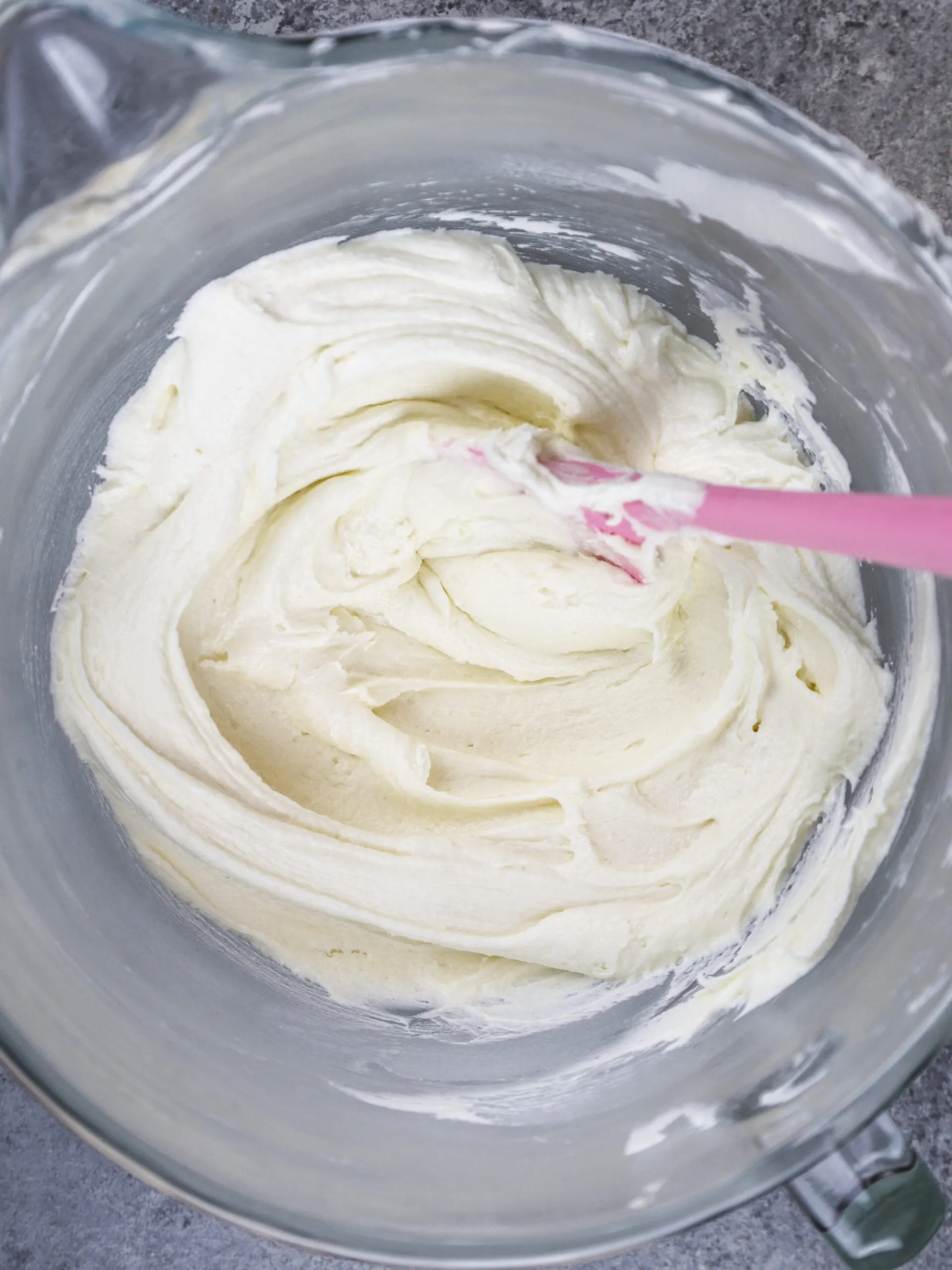
I’m sorry to ruin any of those illusions, but it has nothing to do with the type of frosting or ingredients. It all comes down how you make your frosting.
Now don’t get me wrong, it’s great having a go-to frosting recipe that tastes great and that you’re comfortable working with. For me, I use my American buttercream recipe as a base about 90% of the time.
However, the tips I share below can be utilized with most types of frosting ranging from American buttercream, to Swiss meringue, to Russian buttercream.
Why is Smooth Buttercream Important?
Have you ever made a delicious batch of frosting, only to see it riddled with air bubbles as you add it to your cake?
Or have you spent tons of time trying to smooth frosting on your cake, only to end up with a zillion little air pockets all around the sides of your cake??
It can be incredibly frustrating and can make it impossible to get truly smooth sides on your cake.
And it has nothing to do with your cake decorating abilities!! It’s really just your frosting being difficult to work with.
Once I figured out how to make my frosting really smooth, I had a much easier time frosting my cakes with smooth sides.
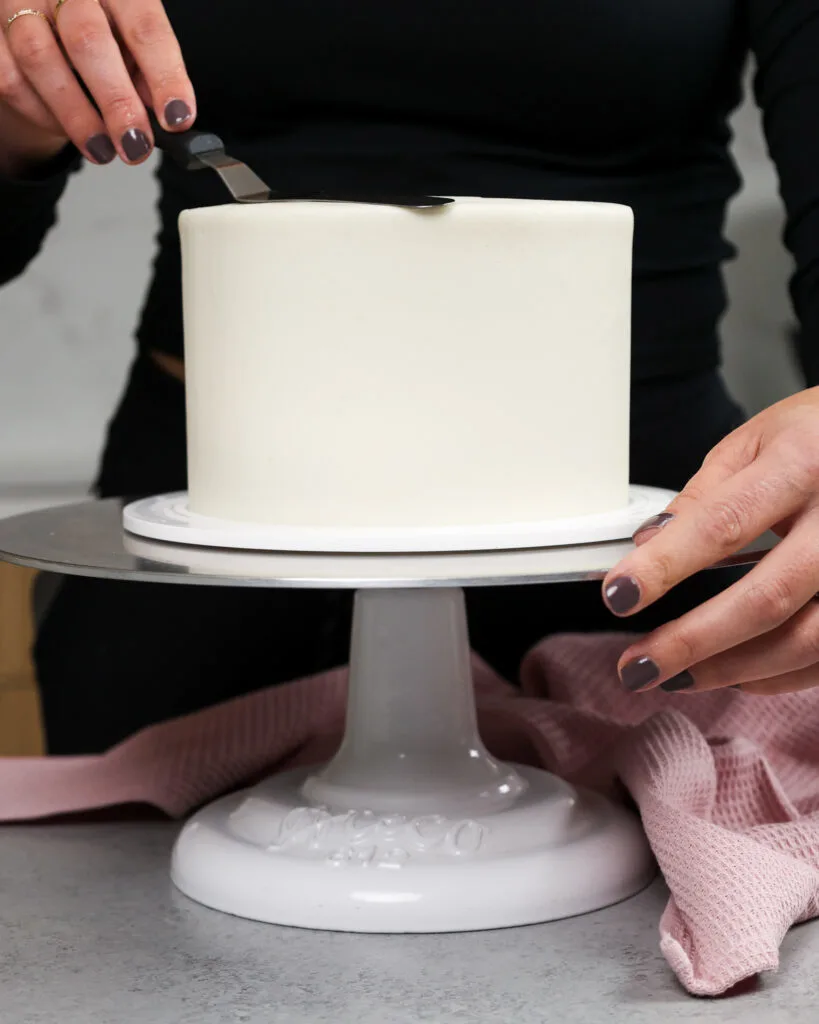
My cake decorating process became much faster and easier. It still takes me time to frost a cake, but I don’t get as stressed out or frustrated as I used to.
Frosting a cake now feels simpler and almost therapeutic.
How I Make Super Smooth Buttercream Frosting
There are a few things I do that make my frosting super smooth.
I never really thought of them as unique or different until I started showing exactly how I make my frosting in private cake lessons.
Whenever I shared my tips, people were quite surprised.
You may have heard of some or all of them, and I don’t think any of them are really groundbreaking.
But when combined, they allow you to make incredibly smooth buttercream frosting.
Tip #1: Use a Paddle Attachment
Most stand mixers (I use a 5 qt KitchenAid stand mixer) come with both a whisk attachment and a paddle attachment.
The whisk attachment allows you to incorporate air into whatever you’re making, which is great for certain desserts like meringues or whipped cream.
It also is necessary to use a whisk attachment to make certain types of frosting like Swiss meringue, Russian buttercream, or Italian meringue.
However, you only need to use the whisk attachment for the first few steps of the process.
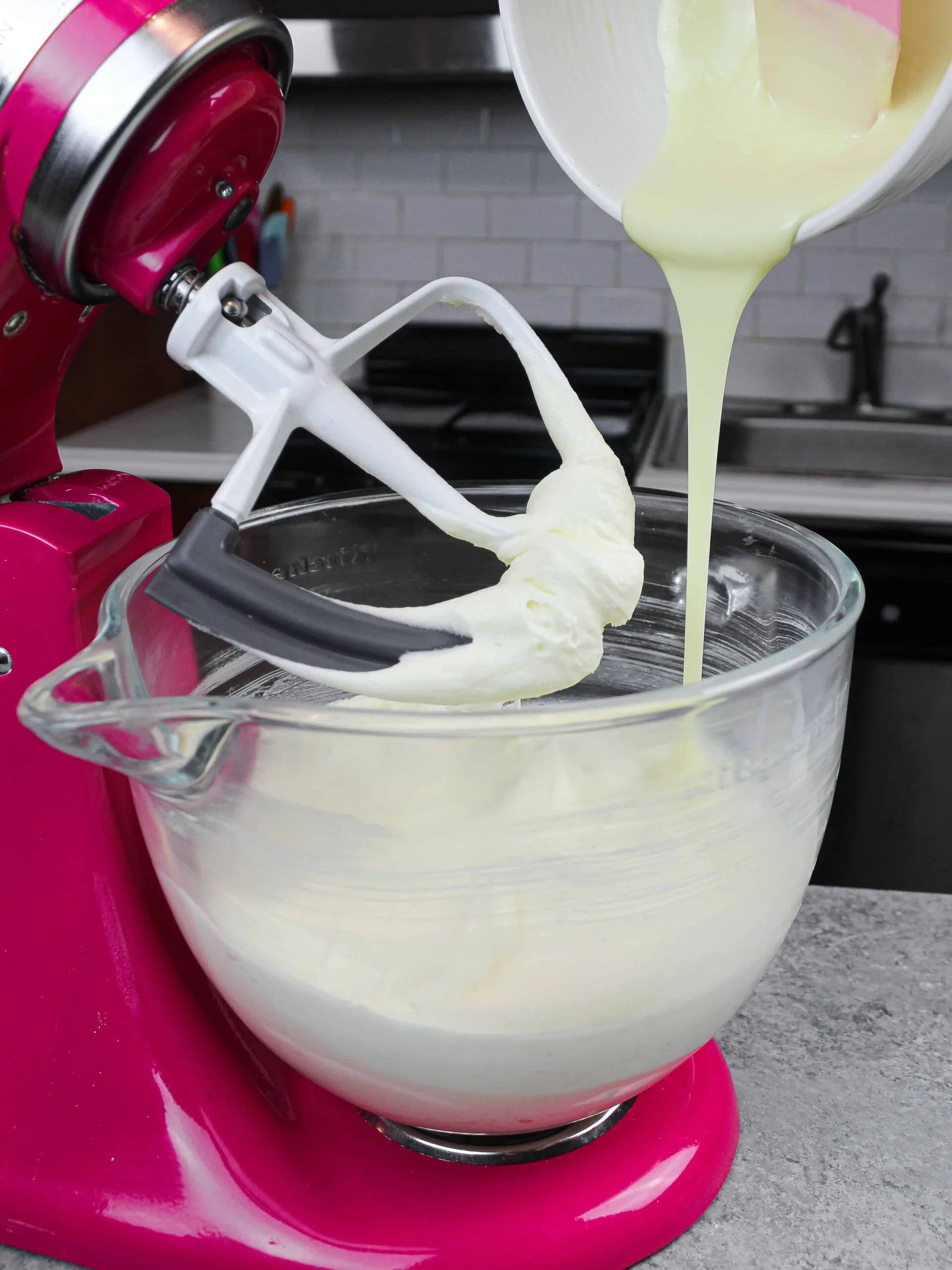
Some types of frosting don’t require a whisk attachment, like American buttercream.
In those situations, I recommend starting with the paddle attachment.
Even if you have to use a whisk attachment at the start of a frosting, you can switch to a paddle attachment once you’ve made your meringue or whipped up your butter.
This allows you to finish combining your ingredients without incorporating tons of air, which reduces the amount of air bubbles in your frosting.
If you don’t have a stand mixer or paddle attachment, it’s ok to use the beaters on a hand mixer.
Just be sure to really focus on my next tip!!
Tip #2: Mix on the Lowest Speed
When I make my American buttercream, I never mix on a speed higher than the lowest setting. I only move my lever to the stir option.
It sounds crazy, but mixing the frosting as slowly as possible also helps make it smooth by minimizing the amount of air that’s getting added in.
It also lowers the chance of you covering your entire kitchen with powdered sugar clouds.
While this isn’t possible for other types of frosting, you can still utilize this tip at the end of the process.
No matter what type of frosting you make, I recommend mixing your frosting on the lowest speed for a couple minutes with a paddle attachment at the end of the process.
This helps push excess air out of the frosting, which makes it nice and smooth.
Don’t be afraid to let your mixer run on low for a few minutes. It makes such a big difference in the texture of the frosting.
It’s pretty difficult to overmix your frosting, especially when you’re mixing it on a low setting.
Tip #3: Get the Consistency Right
The two tips above are great, but if your frosting isn’t the right consistency in the first place, you will still struggle getting smooth sides on your cake.
I find my frosting is the smoothest when I get the consistency just right.
This is a delicate balance between the temperature of your kitchen, the type of bowl you use, the temperature of your butter, and the amount of heavy cream used.
It seems like it shouldn’t be that complicated, but each of those variables can have a big impact on how your frosting turns out.
I actually have a whole separate post about making your frosting the perfect consistency.
It might seem excessive, but the neurotic frosting lover in me felt it deserved its own post.
Tip #4: The Spatula Test
The easiest way to see if your frosting is the right consistency is to do (what I like to call) the spatula test.
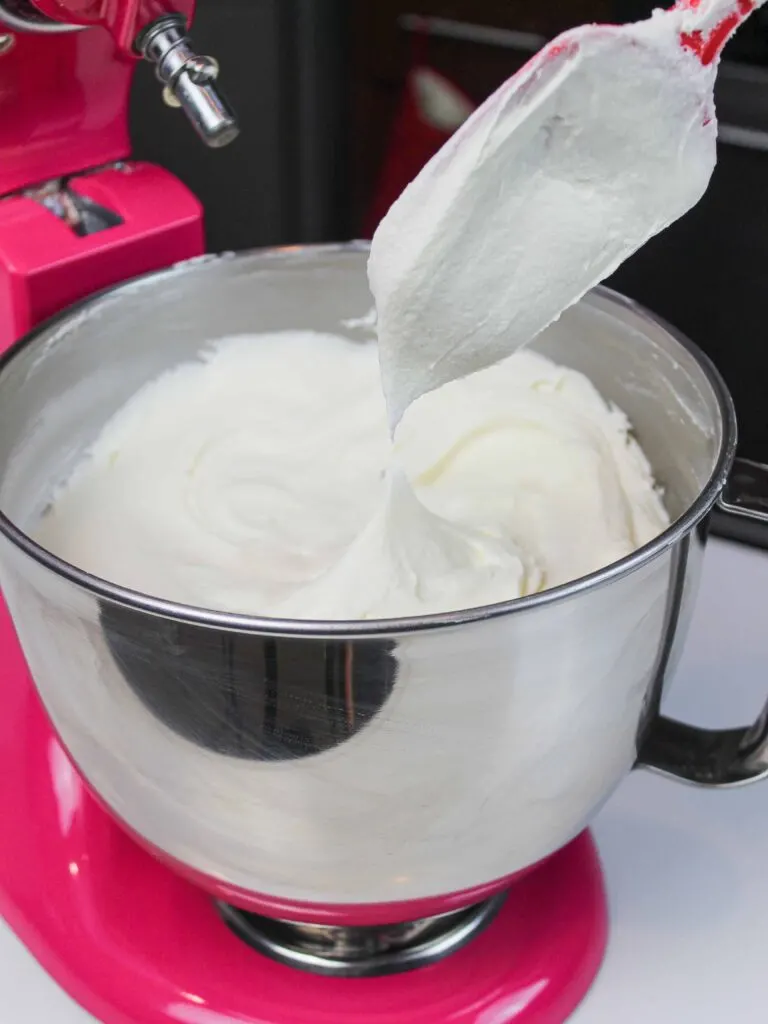
This test confirms that your frosting is stiff enough to hold its shape, but thin enough for you to easily frost your cake.
I like to use this test with American and Russian buttercream, and I do it with every batch of frosting I make.
Firmly press a rubber spatula into your frosting, and pull directly up. Turn the spatula right side up, and look at the frosting on the tip of the spatula.
It should form a somewhat soft peak that has a little curl on the end.
It’s stiff enough to hold up that curl, but soft enough to create that little curl. That little curl is a great visual cue to know that your frosting is just right.

If it’s too stiff and sticks straight up, I suggest adding in more heavy cream (1 Tbsp at a time).
If it’s too thin and doesn’t form a little peak at all, try adding a bit more powdered sugar (1/4 cup at a time) or chill it in the fridge in 5-minute intervals.
After each adjustment, be sure to retest the frosting with your spatula before making any additional changes.
Tip #6: Mix by Hand at the End to Get Rid of Any Pesky Air Bubbles
This final tip I think is the simplest, but also has the biggest impact.
Once I’ve made a batch of frosting and it’s the perfect consistency, I don’t stop there.
I aggressively grip a rubber spatula and work the frosting around the bowl by hand.
Now I know you’re thinking, but I just had my mixer beat my frosting on low for a long time!! Shouldn’t that have pushed out enough air??
The mixer is great, but this final step makes it silky smooth. There’s something about stirring by hand that a stand mixer can’t replicate.
I push the frosting back and forth and spread it along the sides of the bowl for a couple minutes.
Please watch the video that’s in this post to see what I mean.
If you do it right, it should be a pretty serious arm workout. I’m always tired by the end!
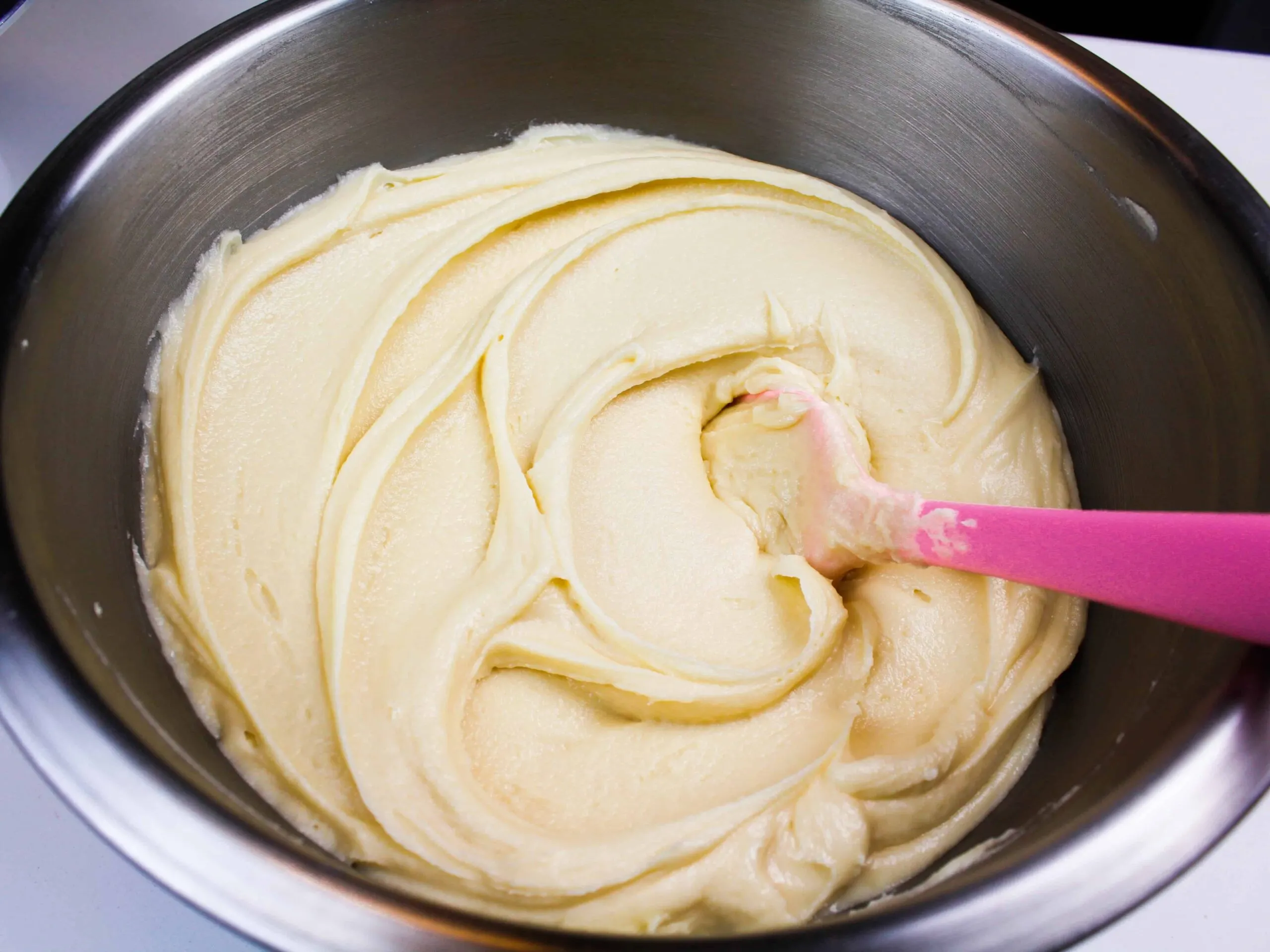
Then, and ONLY then, is your frosting smooth and ready to be added to your cake. You should see a notable difference in texture, and your frosting should be free of any air bubbles.
This is also important to do when you make frosting in advance and let it thaw.
I find my frosting is straight up riddled with air bubbles once it’s thawed.
I usually go to town stirring it by hand, and find it’s nice and smooth after a few minutes of aggressive stirring.
Tips #6: Repeat Step #5 As Needed
Your frosting might be perfectly smooth now, but sadly it won’t stay that way forever. It doesn’t matter how perfect it was when you started.
As your frosting sits out at room temp, it will slowly develop air bubbles.
But fear not, it can easily be fixed. Just give your frosting another good stir by hand with your rubber spatula.
I always have to do this after I crumb coat and chill my cake.
By that point in the process, my frosting usually has been sitting out for at least 30 minutes. That’s long enough for air bubbles to form.
I stir it for a few minutes by hand before taking my cake out of the freezer, and don’t stop until it’s nice and smooth again.
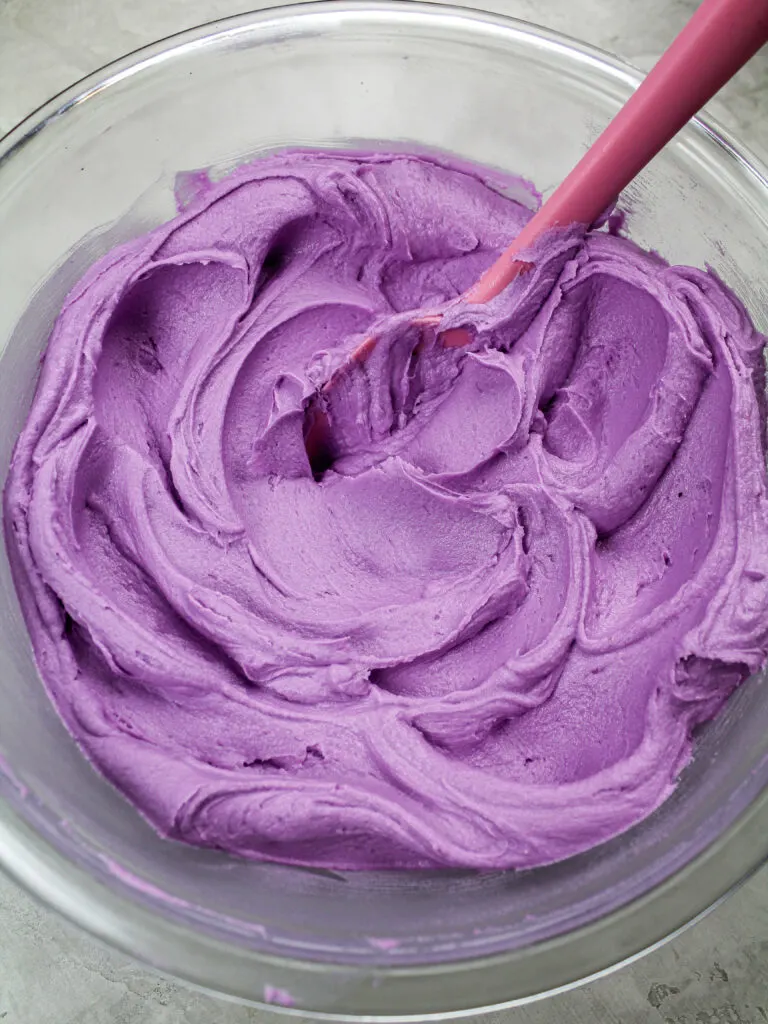
There’s no point in making super smooth buttercream only to let your frosting get air bubbles as you add your second layer of frosting.
That’s when the smoothness of your frosting matters the most!!
Take the extra few minutes to stir it before adding your final layer of frosting.
Let Me Know What You Think!
If you try out these tips to make smooth buttercream frosting, I’d love to hear how they work for you!
Please leave a comment below and let me know if you use any other tricks to make silky smooth buttercream.
If you share on social, don’t forget to tag me @chelsweets and use #chelsweets so I can see your amazing creations!
Other Recipes You Might Like:
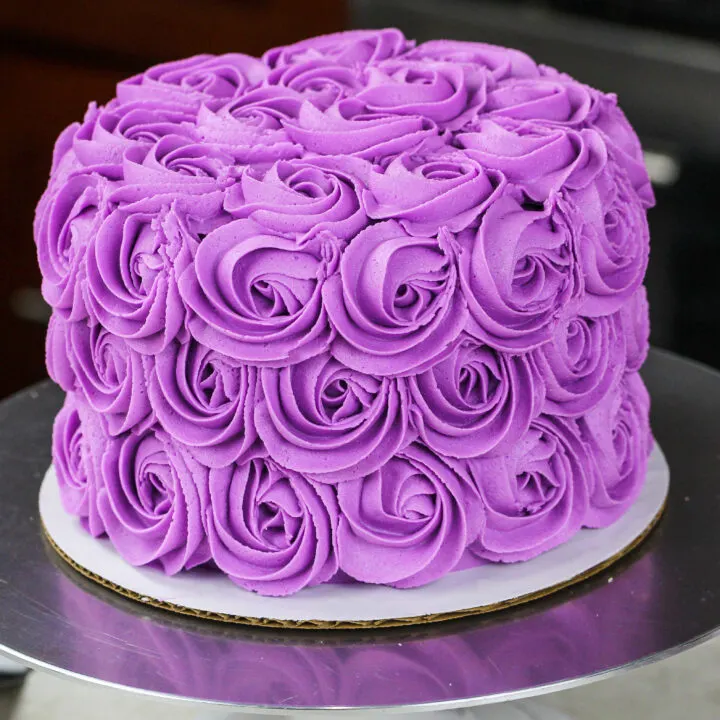

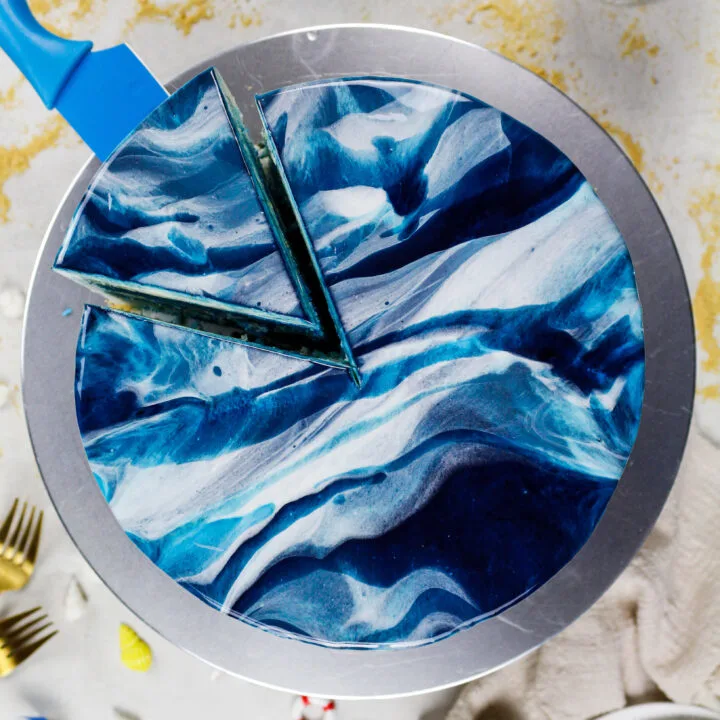
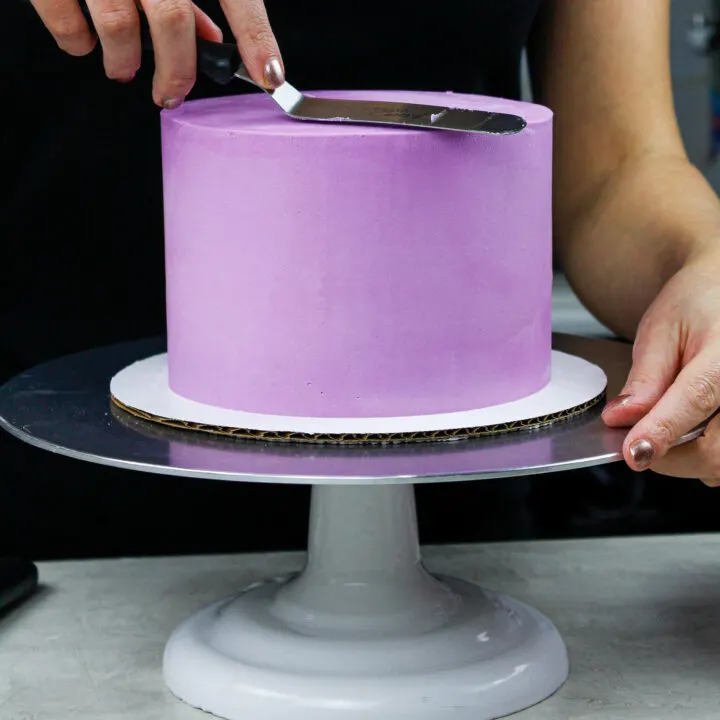
Vanilla Buttercream Frosting
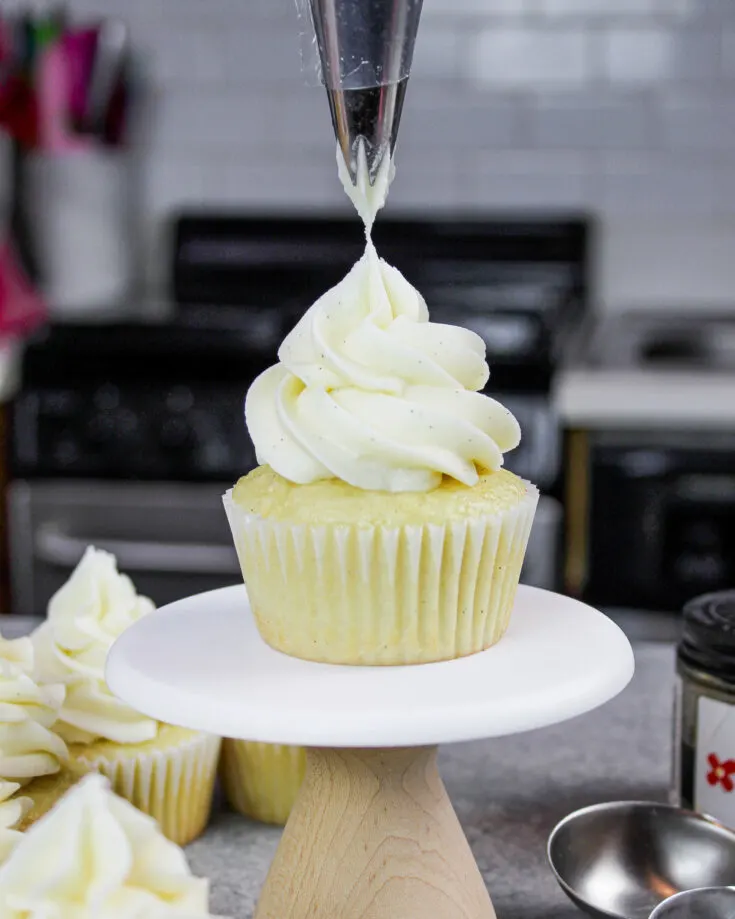
This American buttercream recipe only uses five ingredients! It's so delicious and easy to make, you'll never buy frosting again!!
Ingredients
- 2 cups unsalted butter, room temperature (452g; 1 lb. box)
- 1 Tbsp vanilla extract or vanilla bean paste (12g)
- 1/2 tsp fine salt (3g)
- 7 cups powdered sugar (907g; 2 lb. bag)
- 3 Tbsp heavy cream or whipping cream (45g)
Instructions
- Beat 2 cups of unsalted butter on medium speed for 30 seconds until smooth with a paddle attachment / stand mixer or a hand mixer.
- Mix in 1 Tbsp vanilla extract or vanilla bean paste and 1/2 tsp salt on a low speed.
- Slowly add in 7 cups of powdered sugar while mixing slowly on the lowest setting. Halfway through add in 3 Tbsp of heavy cream or milk to make it easier to mix. I like to place a kitchen towel over my mixer to contain any powdered sugar clouds.
- Mix on low until the ingredients are fully incorporated and the desired consistency is reached. Scrape the sides and bottom of the bowl as needed with a rubber spatula.
- If the frosting is too thick, add in additional cream (1 Tbsp at a time). If the frosting is too thin, add more powdered sugar (a quarter of a cup at a time).
- If you plan to color the buttercream, add in the gel food coloring once the frosting is fully mixed and beat on low until it reaches the desired color.
- To make the frosting extra smooth, stir it by hand with a rubber spatula for a minute or two right before you use it. It's an arm workout, but it's worth it! Push the frosting back and forth and spread it around the side of the bowl. This will push out any extra air and make it easier to smooth onto cakes or pipe with.
Notes
Yield:
One batch of buttercream makes about 6 cups, which is enough to frost a 7-inch or 8-inch layer cake with 3 layers, or frost about 3 dozen cupcakes.
If you're struggling to get your frosting smooth I share all my tips for making super smooth buttercream here.
Making This Vanilla Buttercream Frosting in Advance:
Make your frosting ahead of time or save any leftover frosting! It can be stored in an airtight container in the fridge for up to a month, or in the freezer for up to 3 months.
Be sure to give it a good stir once it thaws to get the consistency nice and smooth again.
A frosted cake can last in the fridge for up to a week, or in the freezer for up to a month. The buttercream locks in all the moisture, keeping the cake fresh and delicious!
If you cut into the cake and have leftovers, use any remaining frosting to cover the cut section to keep it moist and store it in the fridge for up to a week.
If you are making this frosting for a cake, mix the buttercream on the lowest speed at the end of the process for a couple of minutes, to get out any extra air that might have been incorporated during the mixing process.
Nutrition Information
Yield
6Serving Size
1Amount Per Serving Calories 1091Total Fat 66gSaturated Fat 41gTrans Fat 0gUnsaturated Fat 21gCholesterol 177mgSodium 208mgCarbohydrates 129gFiber 0gSugar 126gProtein 1g

Ummi
Thursday 26th of October 2023
My concern is condensation of frosted cake, how do i deal with it?
Chelsweets
Sunday 29th of October 2023
Hi Ummi,
Condensation can be challenging, especially if you live somewhere warm or humid! I'd recommend avoiding putting the cake in the freezer, and trying to minimize the temperature change the cake goes through. For instance, if you have to store it in the fridge overnight, turn the AC up in you kitchen so that when you take it out there won't be as big of a temperature change. This can help minimize condensation. Some people also recommend storing cakes in boxes in the fridge and when you remove them to help with the temperature change. If it's really moist and the frosting is thoroughly chilled, you can also gently pat the sides of the cake with a paper towel to absorb some of the moisture. Hope that helps, happy baking!
Finding the Perfect Frosting for Lemon Cupcakes – Little Upside Down Cake
Saturday 26th of August 2023
[…] Prepare the Butter: Start by ensuring that your butter is at room temperature. Softened butter blends more easily and results in a smoother frosting. […]
Peanut Butter Swiss Meringue Buttercream Recipe - Chelsweets
Monday 31st of July 2023
[…] Calculator Smooth Buttercream Tutorial Strawberry SMBC American […]
Lori
Friday 24th of February 2023
I have followed all these steps, made sure everything was room temp,etc and sifted my powdered sugar. Several times, this has come out with a very grainy appearance. Do you have any idea why or any suggestions? I don't know how to get it smooth and would appreciate any help!
Lori
Monday 6th of March 2023
@Chelsweets, I used unsalted butter from aldi or Kroger. I used 3TBSP of heavy cream. Do you have any suggestions of how much more to add? Thank you so much for your help!
Lori
Tuesday 28th of February 2023
@Chelsweets, It doesn't appear grainy. I use either Kroger or aldi brand. Both bags have the 10x powdered marking on it like you said the domino I think did. I also sifted it last time and no success. Could it be too little liquid or maybe the butter isn't quite right?
Chelsweets
Tuesday 28th of February 2023
Hi Lori,
If not of the tips above are working, the issue might be the type of powdered sugar you're using. Does it look grainy, or does it feel grainy? Some brands of powdered sugar are less refined than others. What brand of powdered sugar are you using? Hopefully we'll be able to figure it out together!
Anne
Tuesday 14th of February 2023
Just made this frosting for the 1st time it is truly smooth and it's also delicious. I made the recipe but made it one and a 1/2 times. This is truly the 1st time I've ever had a butter cream recipe that wasn't grainy. Thank you!
Chelsweets
Tuesday 21st of February 2023
So happy to hear that Anne :) YAY!!!!! Thank you for sharing!